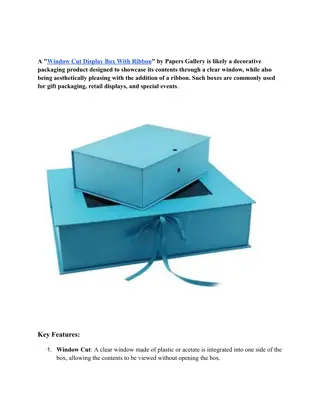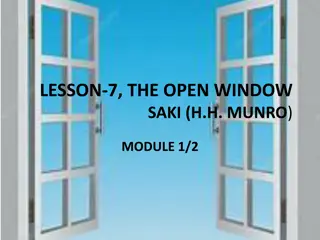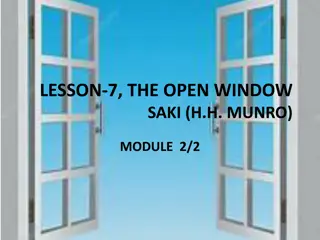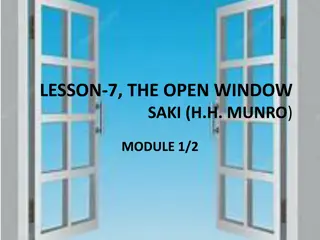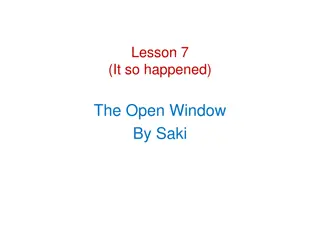Analysis of Saki's "The Open Window
Saki's "The Open Window" is a cleverly crafted short story revolving around a practical joke played by a young woman, Vera, on an unsuspecting visitor. The plot unfolds through the exposition, complications, climax, resolution, and conclusion stages, highlighting Vera's storytelling skills and the twist ending that exposes her as a talented liar. The story employs a tripartite structure, satirizing the Edwardian upper-middle-class society by subverting traditional norms and introducing elements of death and delusion in a seemingly calm setting.
Download Presentation

Please find below an Image/Link to download the presentation.
The content on the website is provided AS IS for your information and personal use only. It may not be sold, licensed, or shared on other websites without obtaining consent from the author.If you encounter any issues during the download, it is possible that the publisher has removed the file from their server.
You are allowed to download the files provided on this website for personal or commercial use, subject to the condition that they are used lawfully. All files are the property of their respective owners.
The content on the website is provided AS IS for your information and personal use only. It may not be sold, licensed, or shared on other websites without obtaining consent from the author.
E N D
Presentation Transcript
SAKIS THE OPEN WINDOW Analysis
THE OPEN WINDOW: PLOT Plot structure of the Open Window "The Open Window" by Saki is a short story about a dual-layered practical joke a young woman (Vera) plays on an unsuspecting visitor. The plot points can be broken up according to the plot triangle as follows: Exposition: A man named Framton Nuttel is visiting the Sappletons. He must wait for Mrs. Sappleton, so 15-year old Vera keeps him company. "'My aunt will be down presently, Mr. [Framton] Nuttel,' said a very self- possessed young lady of fifteen, 'in the meantime you must try and put up with me.'" Complications: Vera explains the tragedy, and tells Framton that they keep the window open in memory of Mr. Sappleton. After talking with Vera for a while, Nuttel is introduced to Mrs. Sappleton. Mrs. Sappleton talks on about her husband and brothers, who Vera has just explained are dead. Framton believes Mrs. Sappleton is insane, and tries to avoid the subject of the husband. "She rattled on cheerfully about the shooting and scarcity of birds...to Framton it was all purely horrible."
PLOT: CONTINUES Climax: As the sun begins setting, three figures walk across the lawn and can be seen from the window. "In the deepening twilight three figures were walking across the lawn towards the window, they all carried guns under their arms." Resolution: Framton, frightened upon realizing the figures are the ghosts of the Sappletons, grabs his things and leaves the house to escape the assumed ghosts. "Framton grabbed wildly at his stick and hat; the hall door, the gravel dive, and the front gate were dimly noted stages in his headlong retreat." 'A most extraordinary Mrs. Sappleton...'One would think he had seen a ghost.'" Conclusion: The family thinks Framton is crazy because he ran away, and it is revealed that the Sappleton "ghosts" are just figments of Vera's "romance at short notice" (skill at telling stories). man, Mr. Nuttel,' said
THE OPEN WINDOW:TRIPARTITE STRUCTURE The story has a tripartite structure. The first part begins with the meeting between Vera and Framton. The second entrance of the aunt and the dialogue between her the guest. The third part comprises the return of the hunting party and how the visitor flees. The narrator employs flashback to divide these three parts, interrupting the present with a story-within-story imagined past. The end is surprising when the reader discovers that Vera is a liar. part starts with the inspired by the girl's
THE OPEN WINDOW : SATIRE Saki's stories frequently satirize and subvert the order of the Edwardian upper-middle class world of which Saki was a part. In this story, he does so by troubling and transforming the rural and calm setting of the formal house visit. Vera's story imbues the otherwise mannered and bourgeois scene with a grim tale of death and delusion. The supernatural theme invades and transforms the otherwise calm Edwardian sitting room. As the men approach the house, they are described in horror-inducing language; they are three figures that appear in the deepening twilight and noiselessly approach the house like phantoms.
THE OPEN WINDOW: IRONY Vera s Name (Verbal Irony).Vera s name is a play on the word 'veracity', meaning 'truth'. Ironically, she is the trickster of the story, always spinning a new tale to her audience. Girl Trickster (Situational Irony). In Saki s time girls were frequently portrayed as trustworthy and honest people. It is thus ironic that he chooses a female character to play the role of trickster and storyteller in The Open Window. Framton's Fright (Situational Irony). Framton retreats to the countryside in order to recover from a bout of nerves. Ironically, the countryside only adds to his anxiety and Framton is thrown into another nervous fit when he believes he has seen ghosts.
IRONY: CONT. Situational irony: The whole story is built on situational irony. The reader, like Mr Nuttel believes in Vera's story till the end; the reader is misled, deceived. He/she doesn't know what has actually happened until the end. The situation becomes ironical in retrospect when the reader actually understood what has really happened. " I hope Vera has been amusing you" ( in fact Mr Nuttel is not amused) " The doctors agree in ordering complete rest, an absence of mental excitement, and avoidance of anything in the nature of violent physical exercise". In fact the reverse is going to take place. "One would think he had seen a ghost". The ghosts were real people. Moreover Mrs. Sappleton was not aware at all of what was really happening.
IRONY: CONT. Verbal irony: Vera communion. Mr Nuttel is ill-at-ease and would like to break that " communion". "She has been very interesting" Mr Nuttel says. In fact he means that he learnt something interesting about her, about her supposedly madness. coincidence". Here the irony comes from the author/narrator. " Do you know, sometimes on still, quiet evenings like this, I almost get a creepy feeling that they will all walk in through that window" Of course she knows that they will come in since they never disappeared. " silent communion"; Between Nuttel, there and Mr is in fact no "






